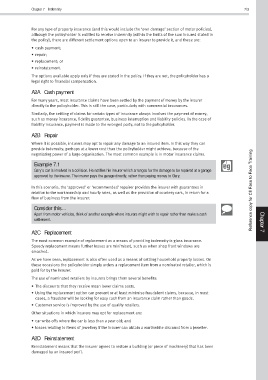Page 105 - W01TB8_2017-18_[low-res]_F2F_Neat
P. 105
Chapter 7 Indemnity 7/3
For any type of property insurance (and this would include the ‘own damage’ section of motor policies),
although the policyholder is entitled to receive indemnity (within the limits of the sum insured stated in
the policy), there are different settlement options open to an insurer to provide it, and these are:
• cash payment;
• repair;
• replacement; or
• reinstatement.
The options available apply only if they are stated in the policy. If they are not, the policyholder has a
legal right to financial compensation.
A2A Cash payment
For many years, most insurance claims have been settled by the payment of money by the insurer
directly to the policyholder. This is still the case, particularly with commercial insurances.
Similarly, the settling of claims for certain types of insurance always involves the payment of money,
such as money insurance, fidelity guarantee, business interruption and liability policies. In the case of
liability insurance, payment is made to the wronged party, not to the policyholder.
A2B Repair
Where it is possible, insurers may opt to repair any damage to an insured item. In this way they can
provide indemnity, perhaps at a lower cost than the policyholder might achieve, because of the
negotiating power of a large organisation. The most common example is in motor insurance claims.
Example 7.1
Gary’s car is involved in a collision. He notifies his insurer which arranges for the damage to be repaired at a garage
approved by the insurer. The insurer pays the garage directly, rather than paying money to Gary.
In this scenario, the ‘approved’ or ‘recommended’ repairer provides the insurer with guarantees in
relation to the workmanship and hourly rates, as well as the provision of courtesy cars, in return for a Reference copy for CII Face to Face Training
flow of business from the insurer.
Consider this…
Apart from motor vehicles, think of another example where insurers might wish to repair rather than make a cash
settlement. Chapter
A2C Replacement 7
The most common example of replacement as a means of providing indemnity is glass insurance.
Speedy replacement means further losses are minimised, such as when shop front windows are
smashed.
As we have seen, replacement is also often used as a means of settling household property losses. On
these occasions the policyholder simply orders a replacement item from a nominated retailer, which is
paid for by the insurer.
The use of nominated retailers by insurers brings them several benefits:
• The discounts that they receive mean lower claims costs.
• Using the replacement option can prevent or at least minimise fraudulent claims, because, in most
cases, a fraudster will be looking for easy cash from an insurance claim rather than goods.
• Customer service is improved by the use of quality retailers.
Other situations in which insurers may opt for replacement are:
• car write-offs where the car is less than a year old; and
• losses relating to items of jewellery if the insurer can obtain a worthwhile discount from a jeweller.
A2D Reinstatement
Reinstatement means that the insurer agrees to restore a building (or piece of machinery) that has been
damaged by an insured peril.

